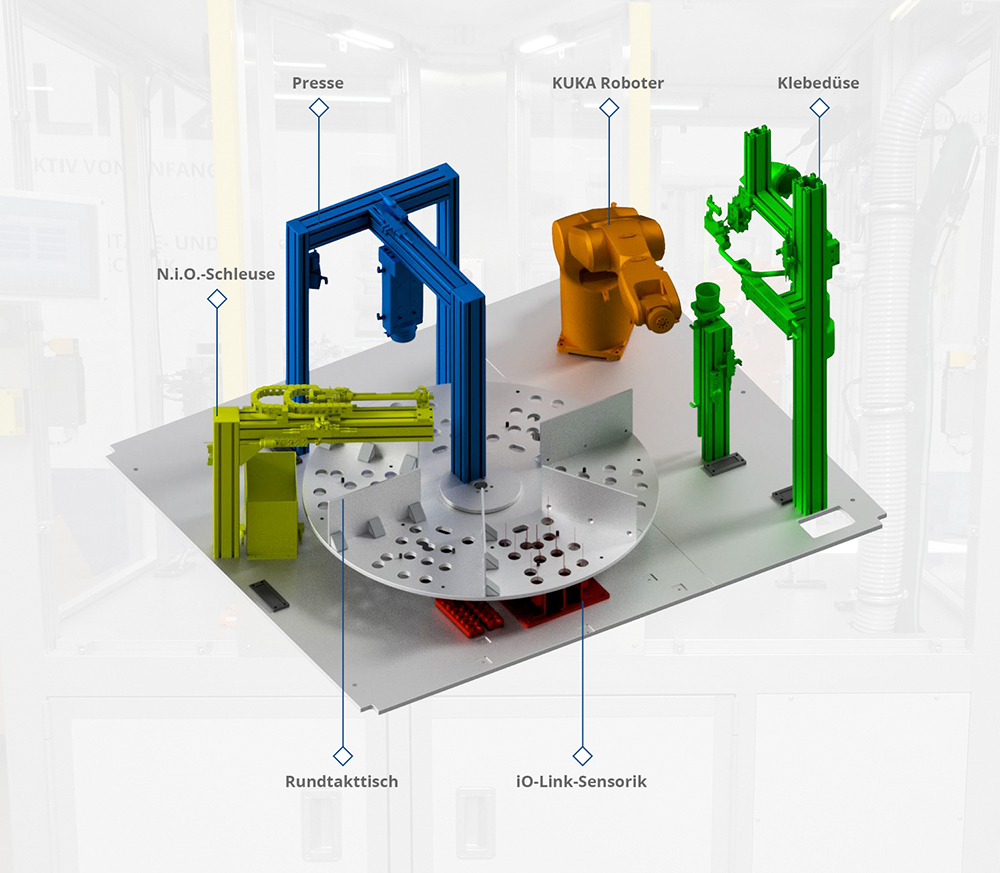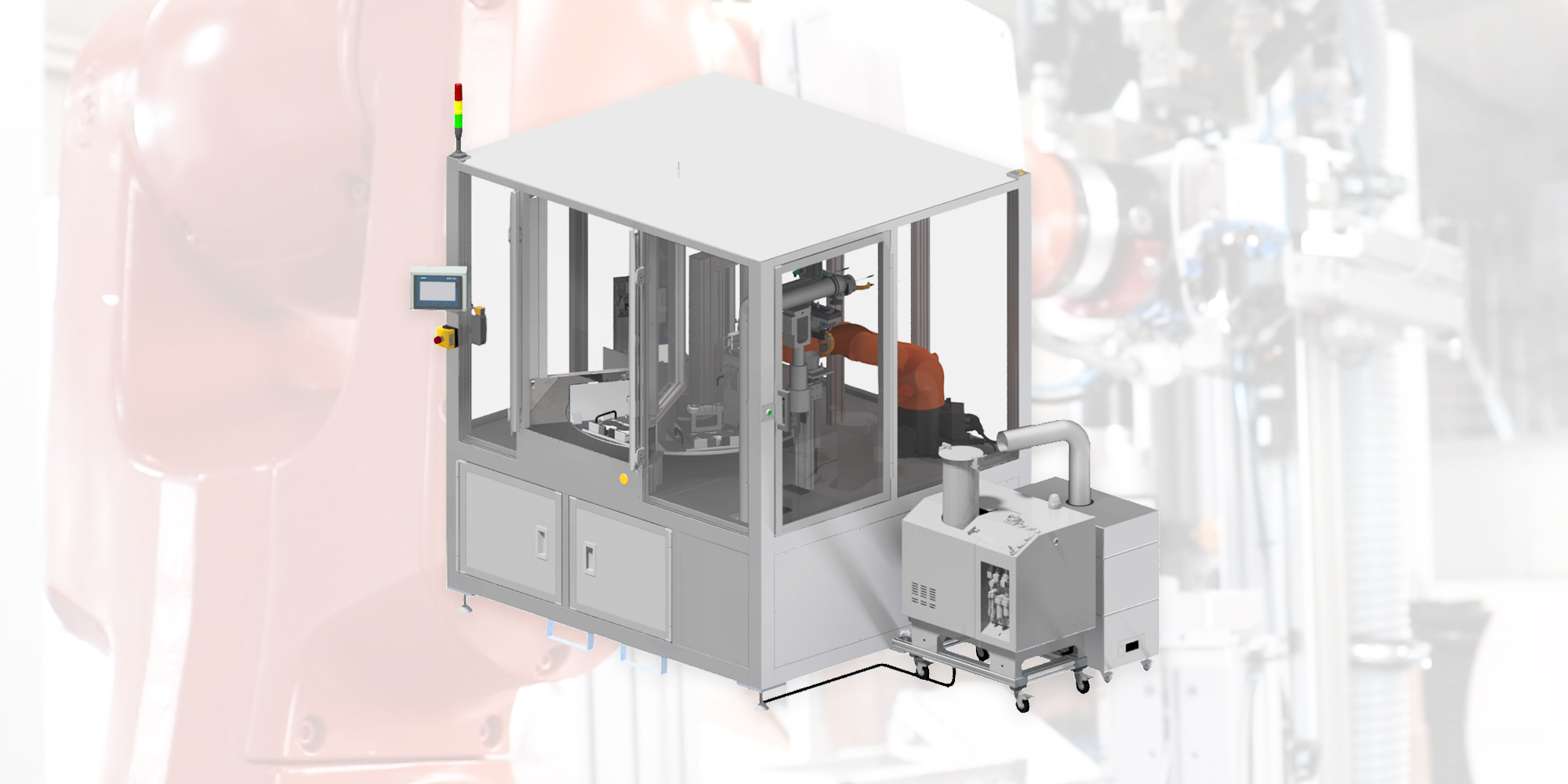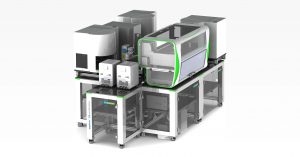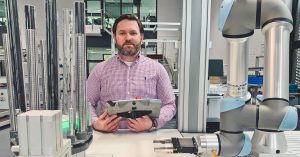Lenkering Montage- und Zerspanungstechnik GmbH (LMZ) from Steinfeld-Mühlen in northern Germany is a member of the item pluspartner network and uses intelligent concepts for Industry 4.0 requirements.
Managing Director Dennis Lenkering and his team focus on state-of-the-art automation solutions for component assembly, inspection and packaging. Optimising the technical performance and cost-efficiency of these very production processes is invaluable, especially for automotive industry suppliers. With this in mind, LMZ has developed a new semi-automated gluing system that meets Industry 4.0 requirements for a plastics manufacturer in the automotive sector. The system’s internal workflow is simple. A KUKA robot picks up the component, which is fed in by a rotary indexing table, and places it underneath a nozzle that applies a specified quantity of glue. The component is then assembled and pressed together. It’s the processes and parameters in the background that are paramount, though. Inside the cutting-edge enclosure, built using Line XMS from item, it all comes down to three things – flexibility, cost-efficiency and top quality for process and component alike.

Perfect protection for production processes
The XMS machine cabin for reliable processes – one user report, three success stories.
GET YOUR COPY NOW
Flexibility, cost-efficiency and further benefits of the gluing system
Ever-increasing demands for personalisation from end customers are throwing up major challenges for the automotive sector and its suppliers, who are having to deal with ever smaller batch sizes and more widely fluctuating order quantities due to the growing number of component variants. “When automating systems that will be producing articles in relatively small quantities, cost-efficiency has to be a particularly important focal point. That’s definitely the case here due to the adaptive design. Rather than four separate systems, only one system is required for all four variants,” explains Torben Fangmann, who is responsible for industry communication at LMZ. Thanks to adaptations, the gluing system is able to put together two different assemblies, one of which even has three variants. The system was designed in such a way that product changeovers can be completed in less than five minutes. The robot arm’s gripper, which has a quick-change system, is correspondingly versatile. “Quality is another key factor. Specific process parameters need to be complied with. In such situations, a semi-automated gluing system is naturally far more reliable than any manual solution,” emphasises project manager Erwin Weihrauch. The only time an operator is required is when components are being inserted or removed.
Parameters include the time between applying the glue and pressing the components together, which must not exceed ten seconds. The intelligent IO-Link sensor technology is a particularly exciting development. “This innovative technology is still far from standard in such systems. Amongst other things, it can ensure process reliability by determining to within an accuracy of around two millimetres whether a component has been placed in exactly the right position,” explains Weihrauch. If parameters are not met, the relevant components are flagged as not okay, isolated and routed to a chute. Right from the outset, this prevents defective components from getting into the production chain. “The costs associated with complaints are always very high for automotive suppliers. Our system’s safety measures specifically prevent problems of this kind,” says Fangmann. The big advantage is that customers can use the dashboard to gain easy access to the sensors at the heart of the system. This means they can still make adjustments themselves, but it also ensures programmers at LMZ can access the system from anywhere to carry out remote maintenance and make vital adjustments to systems located in a completely different country.

Line XMS – the ultimate in safety and stylish design
Safety doesn’t simply mean guarding against component defects, though. It also plays a key role in human-robot collaboration during semi-automated processes. Given that a robot and gluing processes are being used, it’s important to protect staff and the environment from potential risks. With the enclosure based on Line XMS, all processes take place in a safe, enclosed space and glue fumes are removed via a hose. A door made from special Door Profiles XMS that closes with outstanding precision, combined with a release button for access to the insertion area, provides the best possible protection for staff and processes alike.
We’ve been using Line XMS for some time now and have devised a readily identifiable design concept. The closed sides result in a clean, high-quality design.
Pressing the button interrupts all processes in the gluing system. Only then is it possible to open the door. In addition to the excellent quality and modularity of XMS profiles, the design was also a key consideration for the team in charge. “We’ve been using Line XMS for some time now and have devised a readily identifiable design concept. The closed sides result in a clean, high-quality design,” says Weihrauch. “It’s important for the way our solutions look also to emphasise our innovative strength when it comes to Industry 4.0. That’s why we’re big fans of XMS and this design, as also demonstrated by our other equipment systems,” adds Fangmann.
Do you want to keep up to date on innovative ways that item components are being put to use? Then we have the perfect solution for you. Simply subscribe to the item blog by completing the box at the top right.





